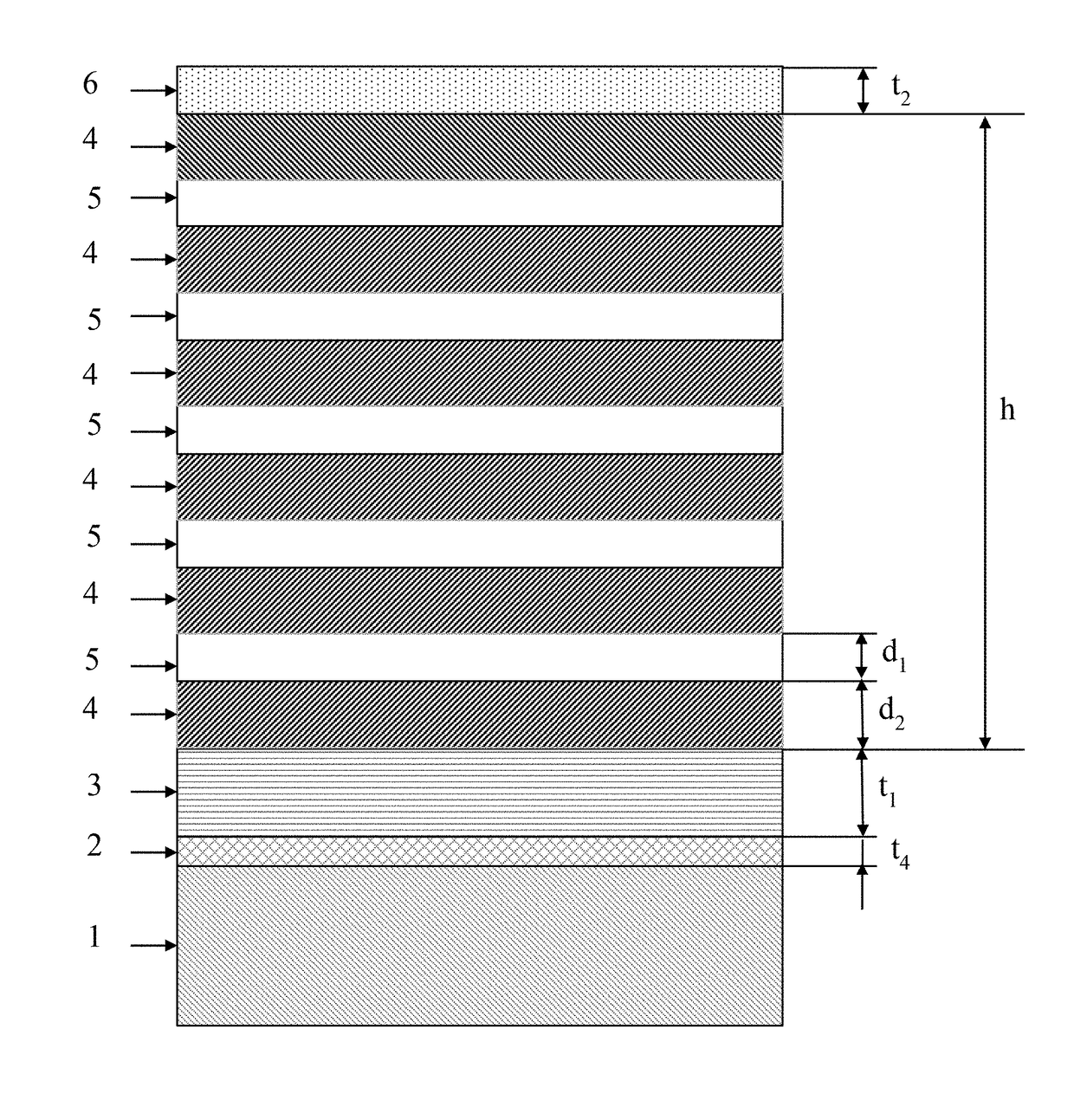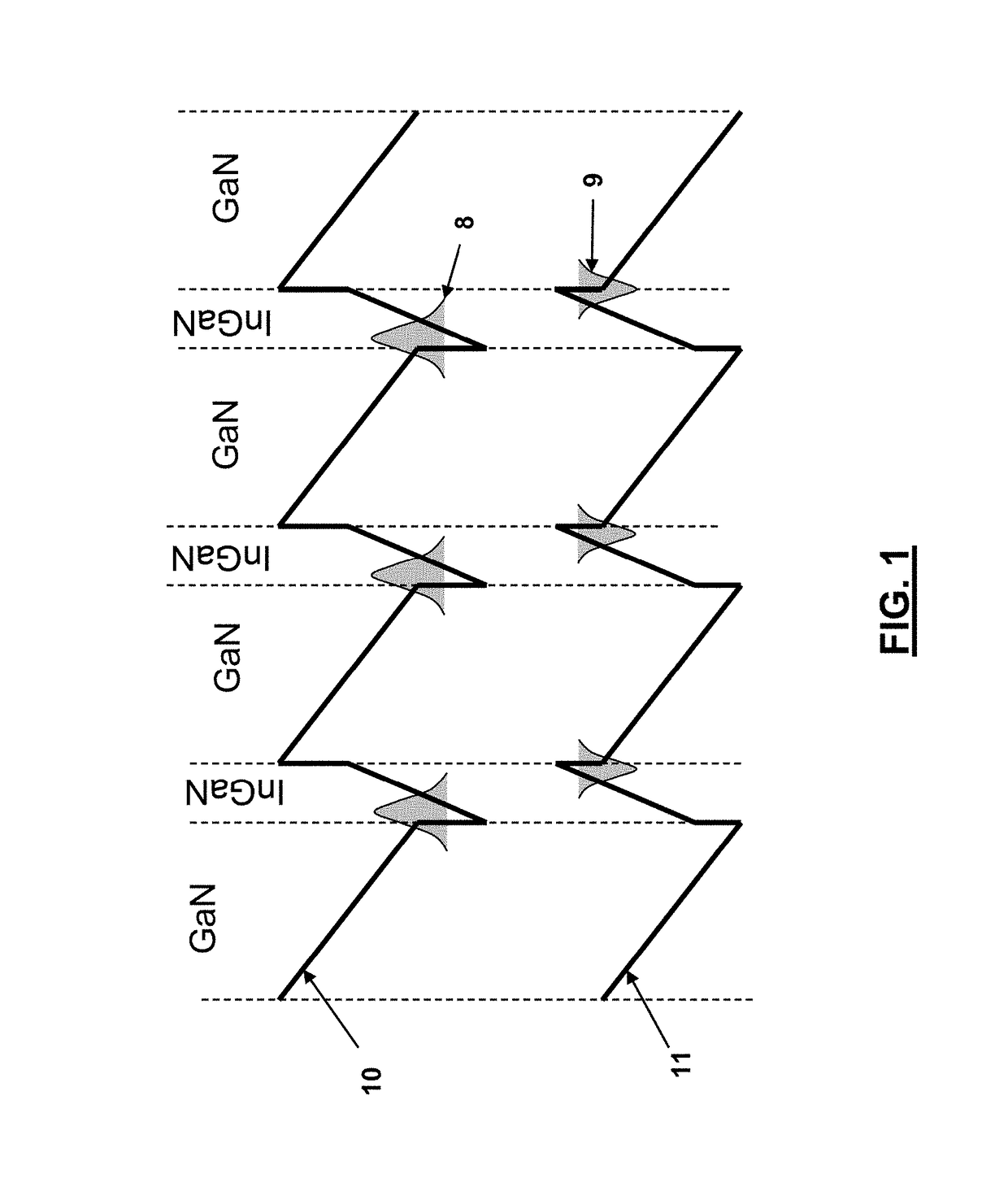Scintillation detector for detection of ionising radiation
a technology of ionising radiation and detector, which is applied in the direction of instruments, particle separator tube details, x/gamma/cosmic radiation measurement, etc., can solve the problem of not considering the strong piezoelectric field, the ratio of consumed energy for radiative and non-radiative recombination still cannot suffice, and the effect of high luminescence intensity and short decay tim
- Summary
- Abstract
- Description
- Claims
- Application Information
AI Technical Summary
Benefits of technology
Problems solved by technology
Method used
Image
Examples
example 1
with Fully Compensated Piezoelectric Field
[0029]A part of the scintillator is a multilayer semiconductor nitride heterostructure with a GaN buffer layer 2 prepared with the MOVPE technology. It is essential for the quality and function of the heterostructure active area that the AlybInxbGa1-xb-ybN barrier layer 4 in the active area is lattice matched to the GaN buffer layer in the epitaxial plane and, simultaneously, that the AlywInxwGa1-xw-ywN layers 5 with a narrower band gap representing potential wells have the same polarisation as the barrier layers 4. The AlybInxbGa1-xb-ybN barrier layer 4 must contain approximately 4.3× more Al atoms than In atoms (yb=4.3·xb), so that it could be lattice matched to the buffer layer.
[0030]The heterostructure is prepared on the YAP (yttrium-aluminium perovskite) substrate 1 with orientation (111). After the preparation, the nitridation was performed of the substrate 1 in the NH3+N2 atmosphere at the temperature of 1050° C. for the period of 5 m...
example 2
with a Partially Balanced Piezoelectric Field and Fully Compensated Strain in Epitaxial Layers
[0031]The multilayer semiconductor heterostructure was prepared according to Example 1 and the composition and thickness d2 of the barrier layer 4 with a smaller lattice constant at, is arranged in such a manner that the strain caused by layer 5 representing a potential well with a larger lattice constant aw and thickness d1 is balanced against the bottom layer 3 with lattice parameter a0, which, in this Example, is created with GaN. Simultaneously, the piezoelectric field is compensated between the layers 4 and layers 5 representing a potential well (both the types have the same polarisation). The active area is created with alternating layers 4 and 5 with a broader and narrower band gaps, prepared at the temperature of 830° C. The number of repetition of the active couples is 30. The parameters of layers 4 and 5 are AlybInxbGa1-xb-ybN, where xb=0, yb=0.15 with the thickness d2 of the laye...
example 4
with an Immersed Carrier Attracting Layer
[0033]This structure (ref to FIG. 3 and FIG. 6) is prepared according to Example 1, however, there is inserted in the layer 5 with a narrower band gap with the AlywInxwGa1-xw-ywN composition a thin InxdGa1-xdN layer 7 as the carrier attracting layer which pulls inside itself electrons and holes and thus improves the overlap of the wave functions of the charge carriers also in the case when piezoelectric field is present, therefore it enables to decrease the aluminium concentration in the active area.
[0034]The structure is prepared on the YAP (yttrium-aluminium perovskite) substrate 1 with orientation (111). The nitridation was performed of the substrate 1 in the NH3+N2 atmosphere at the temperature of 1050° C. for the period of 5 minutes. Subsequently, a nucleation layer 2 from the GaN material was prepared at the temperature of 540° C. whose thickness t4 is 30 run. Then the bottom GaN layer 3 was created, doped with silicon atoms to the conc...
PUM
 Login to View More
Login to View More Abstract
Description
Claims
Application Information
 Login to View More
Login to View More - R&D
- Intellectual Property
- Life Sciences
- Materials
- Tech Scout
- Unparalleled Data Quality
- Higher Quality Content
- 60% Fewer Hallucinations
Browse by: Latest US Patents, China's latest patents, Technical Efficacy Thesaurus, Application Domain, Technology Topic, Popular Technical Reports.
© 2025 PatSnap. All rights reserved.Legal|Privacy policy|Modern Slavery Act Transparency Statement|Sitemap|About US| Contact US: help@patsnap.com



